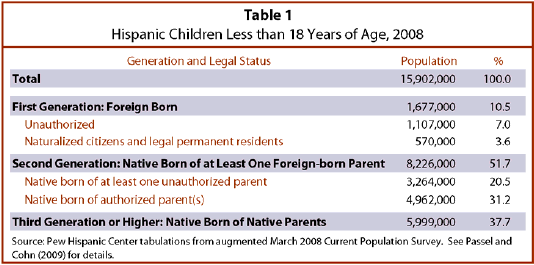The Growth of Hispanic Children
The nation’s 16 million Hispanic children will likely continue to be one of our fastest- growing child populations. The U.S. Census Bureau projects that the number of Hispanic children will rise to 24 million by 2025 (Census Bureau, 2008). The share of children who are of Latino origin is projected to rise to 29% in 2025 from 22% today. In contrast, the Census Bureau projects that the share of children identifying as either non-Hispanic white or non-Hispanic black will continue to fall.
The nation’s 16 million Hispanic children and its 31 million Hispanic adults have very different generational and legal status profiles. Only 11% of Hispanic children were born outside of the United States (Table 1). In contrast, 55% of Hispanic adults were born in another country and migrated to the United States. As a result, far fewer Hispanic children than Hispanic adults are unauthorized immigrants. Building on prior research on the size and characteristics of the undocumented immigrant population (Passel and Cohn, 2009), the Pew Hispanic Center estimates that 1.1 million Hispanic children, or about 7% of all Hispanic children, are unauthorized immigrants (based on March 2008 data collected by the Census Bureau). In contrast, about one-fourth of all Hispanic adults are undocumented migrants.

Undocumented Children and Public Benefits
Undocumented children are eligible to receive some public benefits but not others. They are legally entitled to public education from kindergarten through high school; to some emergency medical care; and to child and school nutrition programs under the Women, Infants and Children (WIC) legislation. They are not eligible for many other federal programs that provide a safety net for children, including the Supplemental Nutrition Assistance Program (formerly known as the food stamp program), Temporary Assistance for Needy Families (TANF), non-emergency Medicaid and the State Children’s Health Insurance Program (SCHIP). Also, undocumented students are not eligible for federal Pell grants for postsecondary education and in most states are not offered in-state tuition at public colleges and universities.
Nearly nine-in-ten Hispanic children under the age of 18 were born in the United States and are therefore U.S. citizens by birth. However, many are not far removed from their immigrant roots. About half (52%) of all Hispanic children are members of the “second generation,” that is, they are the U.S.-born children of at least one immigrant parent. A majority of this large Hispanic second-generation child population is living with a parent or parents who are legal immigrants. However, a sizable minority are in families whose legal status is mixed, as about two-in-ten Hispanic children are U.S.-born children of unauthorized immigrant parents. Finally, about four-in-ten Hispanic children (6 million) are the U.S.-born children of parents who were born in the U.S. By definition, these children are members of the “third generation” or higher, and their families have been in the United States for at least a generation. Some of these children’s families have been in the country for many generations. In fact, persons of Hispanic descent resided in the United States before the American Revolution. The Decennial Census did not consistently count Hispanics until 1970, but the 1930 Census counted 1.3 million “Mexicans” residing in the U.S. (Census Bureau, 1993).




